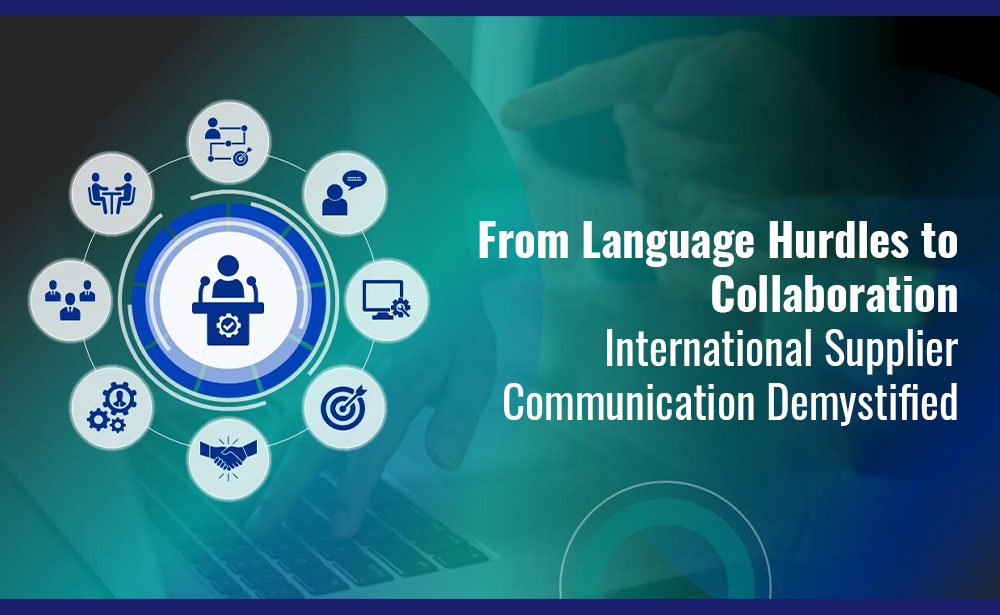In today’s globalized business landscape, international supplier communication is both challenging and necessary. Companies rely on suppliers worldwide to source materials, components, and finished products. However, effective communication with international suppliers can be complex due to language barriers, cultural differences, and varying time zones.
In this guest post, we’ll explore the significance of communication and how it relates to Supplier Qualification Management. We’ll delve into the strategies, tools, and best practices that can help break down barriers and foster successful communication with international suppliers.
Understanding the Importance of International Supplier Communication
Effective communication with international suppliers is essential for several reasons:
- Quality Assurance: Clear and concise communication helps suppliers understand quality standards and requirements. This minimizes the risk of subpar products entering the supply chain.
- Timely Delivery: Communication facilitates the coordination of production schedules and delivery timelines. Delays can be costly, and effective communication helps prevent them.
- Problem Resolution: When issues arise, such as quality defects or delays, swift and accurate communication is vital for resolving problems and preventing them from recurring.
- Compliance: International trade often involves regulatory compliance. Effective communication ensures that both parties understand and adhere to relevant regulations.
- Relationship Building: Good communication fosters trust and collaboration, leading to stronger and more enduring supplier relationships.
Challenges in International Supplier Communication
International vendor communication comes with unique challenges:
- Language Barriers: Language differences can lead to misunderstandings and misinterpretations, affecting the quality of communication.
- Cultural Differences: Different cultures have varying communication styles, expectations, and business practices, which can create friction if not understood.
- Time Zone Differences: Working across time zones can make real-time communication difficult and slow response times.
- Technology Gaps: Suppliers from different regions may have varying levels of technological sophistication, affecting their ability to use digital communication tools effectively.
- Legal and Regulatory Variations: Navigating diverse legal and regulatory frameworks complicates international communication.
The Role of Supplier Qualification Management (SQM)
Supplier Qualification Management plays a crucial role in overcoming the challenges of international communication. Supplier qualification involves assessing and verifying a supplier’s capabilities and communication ability. Here’s how Supplier Management contributes to successful communication:
- Supplier Assessment: Supplier management evaluates a supplier’s language proficiency and communication skills. This assessment helps match suppliers with the communication requirements of the buyer.
- Cultural Sensitivity: Supplier qualification training and evaluation can include cultural sensitivity training, helping suppliers understand the communication norms and expectations of the buyer’s region.
- Technology Standardization: Supplier relationship management often involves aligning suppliers with the buyer’s preferred communication technologies, reducing compatibility issues.
- Regulatory Compliance: Supplier management ensures suppliers know and adhere to communication-related regulations, such as data privacy and export control laws.
- Continuous Monitoring: Supplier relationship management is an ongoing process that includes monitoring communication performance. This ensures that issues are identified and addressed promptly.
Strategies for Successful International Supplier Communication
- Language Proficiency Assessment: Assess the language skills of international suppliers. Consider using standardized language tests or certifications to ensure proficiency.
- Cultural Training: Provide cultural sensitivity training to international suppliers to help them understand your region’s business culture, communication norms, and etiquette.
- Clear Communication Guidelines: Establish clear communication guidelines and protocols. Specify preferred communication channels, response times, and reporting formats.
- Use of Technology: Leverage technology to bridge time zone gaps. Implement collaboration tools, project management software, and video conferencing to facilitate real-time communication.
- Translation Services: When language barriers persist, consider using professional translation services for critical communications, such as legal documents or quality specifications.
- Regular Check-Ins: Schedule regular check-in meetings with international suppliers to discuss ongoing projects, address concerns, and provide updates.
- Feedback Mechanism: Establish a feedback mechanism where suppliers can share their communication challenges and suggest improvements.
Tools for I Communication
- Collaboration Software: Platforms like Slack, Microsoft Teams, and Trello enable real-time communication, file sharing, and project collaboration across borders.
- Translation Services: Tools like Google Translate or dedicated translation software can help bridge language gaps in written communication.
- Video Conferencing: Tools like Zoom and Skype facilitate face-to-face virtual meetings, allowing for more personal and effective communication.
- Project Management Software: Tools like Asana and Monday.com help manage international projects, streamline tasks, and keep all stakeholders informed.
- Supplier Portals: Implement supplier portals or dedicated communication platforms where suppliers can access essential document updates and communicate with your team.
Best Practices for International Vendor Communication
- Establish a Communication Plan: Create a communication plan that outlines the frequency, channels, and protocols for international communication.
- Designate Communication Liaisons: Appoint communication liaisons who are fluent in the language and culture of your international suppliers.
- Regular Training: Provide regular training sessions and resources to help suppliers improve their communication skills and cultural understanding.
- Monitor and Evaluate: Continuously monitor and evaluate the effectiveness of your communication strategies and adjust them as needed.
- Feedback Loop: Encourage feedback from suppliers to identify areas of improvement in your communication processes.
Conclusion
Successful international supplier communication is a cornerstone of efficient and resilient supply chain operations. When language and cultural barriers are effectively addressed through Supplier Qualification Management, businesses can build strong relationships with international suppliers, ensure product quality and safety, and navigate the complexities of global trade. By implementing clear strategies, leveraging technology, and following best practices, organizations can break down barriers and foster fruitful international communication that benefits all parties involved.











